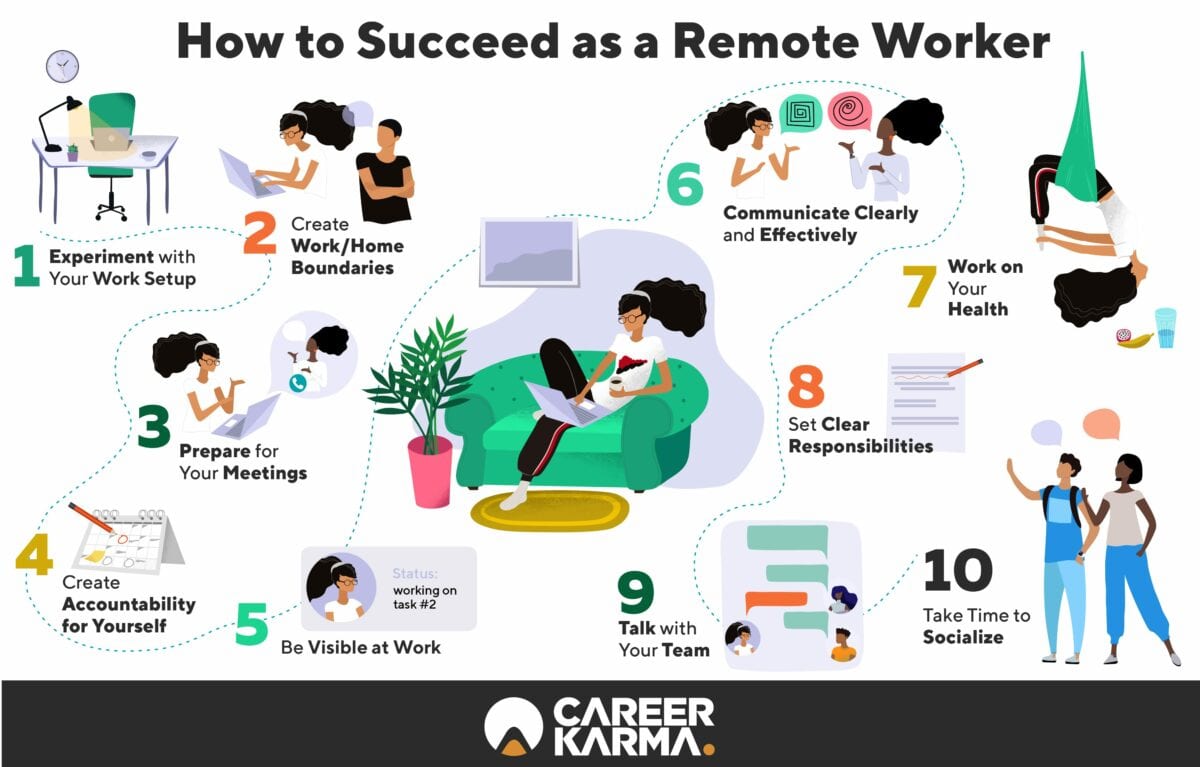Working online or remotely has become a necessity for many this year. However, this is just the start of a larger trend. It is predicted that by 2027, the majority of the US workforce will be working remotely online. The office work lifestyle is familiar to most people. It is getting dressed in your company clothes, commute to work, work in a room with a few other people, take scheduled breaks, etcetera.
But remote workers at online jobs don’t encounter most of those situations. They don’t need to get dressed in company attire or commute to work. But it can be difficult for online workers to navigate working away from the office. Best practices are not well-defined because online work—at least in its current form—is still relatively new. So it can be difficult to know how you should act when working from home.
There is no single formula for how to become an efficient online worker. Everyone will work at different times and have different tips on how to make the most of their time. Indeed, one of the major benefits of remote work is the flexibility it affords. Working from home means that you can adjust your schedule to suit your commitments and your timetable as it is in your hands now. However, this means that you need to learn what works best for you when managing your priorities and time and everyone is slightly different. That said, there are a few common practices you can expect to use as a remote worker.
In this guide, we’ve compiled the best practices for online remote workers. It ranging from how to participate in meetings to how you can find a work from home job without a degree. If you’re working from home or aspire to do so, this guide is for you.
Myths About Remote Working
Before we explore how you can become a great remote worker, we should first look at some myths about working remotely. Many people are skeptical about remote working and some of that skepticism has lead to myths being spread. This paints an inaccurate picture of the true nature of remote work.
Here are a few of the myths remote workers often hear and why they’re misguided:
Myth #1: Remote Workers Need to Prove They Work
n a traditional workplace, your boss or business owner can easily find out if you’re working or not. For example, your boss can walk up to your desk and look at your computer screen or ask you what you are working on. However, this is not the case if you’re a remote worker. Your boss can’t easily check up on you. As a result, many people believe remote workers need to consistently prove they’re working so their boss knows they’re doing their job.
This myth can be dangerous because people believe they need to be always be on and respond to every email or notification as soon as possible. Many remote workers tend to be available most of the time so that it does not look like they are not working. This can cause a number of problems.
Firstly, remote workers can often find it difficult to do any deep work if they are worried about someone looking over their shoulder. Secondly, responding to notifications during every moment you have can make it difficult for you to achieve a good work-life balance.
Remote workers are the same as regular workers. They have to work the same hours, and they have the same work to do. Sure, they’re not in an office, but that doesn’t mean they need to constantly prove they’re working. If you feel you need to prove that you work, realize this: the proof lies in your outputs.
Don’t feel that you need to prove you’re working every moment of the day. If you can meet your goals for the week, everyone will know you’ve been working. Also, you should set aside some time in your calendar for deep work and tell your coworkers you won’t be available during that time. Or set your status on Slack when you’re working on something and do not want to be distracted.
Myth #2: Remote Workers Are Available All Day

Many people assume that working remotely means you are available all the time. If you work from home and spend a lot of time by your computer, then some people assume you would be happy to talk outside traditional work hours.
However, this is completely false. This myth has caused many remote workers to spend more time working than they need to. This is because they have made their home their office and work as if they are in one.
If you’re a remote worker, you should set office hours just like everyone else. Remote workers hours are different depending on their schedule, but they should have a set schedule to complete their projects on time. This also lets everyone knows when you will be working.
Take the lunch breaks you need and move away from your work computer after hours. Don’t respond to messages if you’re in the middle of watching a movie before you go to bed. You should create a barrier between work and the rest of your life.
Luckily, many employers have begun using various remote employee time tracking services to streamline this process for everyone. Time tracking software is becoming increasingly popular as more and more companies are allowing remote work.
Myth #3: Remote Workers Are Lazy

This myth follows from the myth that remote workers need to prove they’re always working. Many people believe that if someone is not sitting at a desk in an office, then they are not actually working.
However, this myth is also false. Just because you’re not sitting in an office space, that does not mean you’re incapable of doing great work. If a remote employee spends their time setting goals and deadlines, and they keep the team updated with their progress, there is no reason to assume they’re lazy.
Further, people can be lazy in an office too. Most office workers can name a few occasions where they have become distracted and accomplished very little work because they were tired or bored.
The best way you can address this myth is to work hard and do your best to meet your goals. When you have proof you’ve been working, nobody can dispute that you’ve been productive. Interestingly, the Global Workplace Analytics Costs and Benefits survey found that teleworkers in a large number of companies actually have between 35 and 40 percent increased productivity over those working in an office.
How to Succeed as a Remote Worker

In the past two years, there has been a 79 percent increase in LinkedIn job posts advertising flexible work arrangements. This means more remote workers are expected to enter the workforce soon. Although it takes some practice, it is possible to become a successful remote worker who has a good work-life balance.
Remote working is very different from working in an office. So there are a few things you’ll need to be aware of to ensure you’re an effective remote worker. In this section, we’ve broken down a few key elements of remote working and shared how you can overcome the core challenges associated with being a remote worker.
Experiment With Your Work Setup

As a remote worker, you have a lot of flexibility over how you work. A traditional office-bound worker would have to work at a certain desk and wear certain clothes. You have more freedom over your choices in where you work, what you wear, and other aspects of the job.
One of the first things you should do as a remote worker is to try out different work set-ups and see what works best for you. Office workers have a specific set of standards they have to meet and a certain schedule. But as a remote worker, you have the ability to choose how your schedule is set up.
It is easy to assume that working remotely means you sit at a desk and not move until your tasks are completed. However, this does not set you up for success. You’ll quickly get tired and bored of your work, and you may even burn out. So, you should spend time trying out a variety of different setups as a remote worker so you can be as successful as possible. The best way you can avoid burning out or getting into a rut is to try different things to change your work habits.
The first thing you can experiment with is when you start. Try starting early in the morning and working through the early afternoon. Another option is to try working a few hours in the morning and a few in the evening. If you’re a morning person, you can work more hours during the day. If you’re a night owl, you may want to stay up late to get your work done. You can also try working from different places, such as a co-working space or a coffee shop. This will allow you to see whether you’re more or less productive when you’re not bound to a desk in your house.
Another thing you should consider is at what times of the day you find it easy to do certain tasks. I prefer to do my creative work — writing — in the morning, when I’m most awake and alert. Then, I do my administrative work in the afternoon and during the evening. You should figure out when you would prefer to do creative and administrative work and develop your schedule around that. Try different break times and work intervals to figure out what’s best for you.

"Career Karma entered my life when I needed it most and quickly helped me match with a bootcamp. Two months after graduating, I found my dream job that aligned with my values and goals in life!"
Venus, Software Engineer at Rockbot
You should also spend some time working on your home office setup. According to Buffer’s State of Remote Work 2019 report, 84 percent of remote workers work from home. But not everyone has a good work setup. Many remote workers have at least once felt they should just sit at a desk in their house and work without customizing your workspace.
However, spending some time to think about where in your home you’ll work is actually very important. You should think about how comfortable you find your chair and whether your desk is set up correctly. Aside from preventing injuries such as Carpal Tunnel, spending time developing a good work setup can also make you more productive. Add some flowers to your room, or change your keyboard to a better option.
Here are a few things you can experiment with as a remote worker:
- Where you work — co-working space, cafe
- What you wear — pajamas, casual clothes, business clothes
- What times you work and when you start
- What type of work you do during certain times of the day — creative work, monotonous work
- When you take breaks and what you do during those breaks — go out for a walk, eat a snack or meal
- What you listen to in the background
Create Work Boundaries

It can be easy for remote workers to lose their grasp of a work-life balance. Because many remote workers work from home, many begin to associate being at home with working. You wake up and start working, and you don’t want to stop because you’re still in your office — your home. But this is not sustainable. As a remote worker, it’s crucial that you develop boundaries between your work and the rest of your life. If you don’t, you can work too much and end up feeling as though you are bored of your work.
Here are a few tips on how to create good boundaries between work and home:
Establish Clear Office Hours
Even though you’re not working from an office, you should still set up some office hours. Decide what times you’ll be working and when you finish for the day. And when you’re finished, make sure you do not complete any more work tasks. When you have set office hours, it is easier for you to transition from working to relaxing after a long day.
You should also share your office hours with your family. Because you work from home, they may feel as if you’re always available. Make sure they understand that you work during certain times of the day and give them a schedule of when you will be working if they need it. This will reduce the chance a family member calls you up to do something for them when you’re supposed to be doing deep work.
Create a Dedicated Workspace
It can also be helpful to set up a dedicated place where you’ll work from during your day. Many remote workers decide to work from their regular desk because everything is already set up. However, this often results in you mixing your work and relaxing space. It can become difficult because you associate the two together.
You should try to set up a specific place in your house where you work, which is different from where you relax. Don’t work on your couch if that is also where you go and watch television. Instead, work from a table or a desk somewhere that becomes routine where you should work.
Use Props
Some remote workers use an object to help trick their brains into thinking it is time for work and time to relax. For example, you could wear a certain pair of shoes during the time you are supposed to work. Over time, your body will get used to the fact you wear those shoes when you work. So when you are not wearing those shoes, your brain will know it is time for you to relax. This could be anything, whether it be shoes, a shirt, or something else.
Turn Off Notifications

When you receive a notification, you can often feel as if you should respond to it immediately. Even when a notification is not important, our brain can feel tempted to respond because doing so feels great — we have accomplished another task.
However, this can make it difficult for you to develop a balance between work and life. Therefore, you should turn off your notifications for work-related tasks at certain times of the day. After your office hours are complete, you should set your Slack or other chat app that you use for work to “do not disturb”. Many remote working tools also allow you to set a work schedule so this will happen automatically.
If you turn off your notifications when you’re not working, it will be easier for you to relax. You don’t have to feel like you’re always working and after the day is over, you don’t have to worry about notifications and feel stressed.
If you are finding this difficult, you may want to tell your co-workers that you’re going to turn off your notifications during certain times. You can tell them that if they need you for an emergency, then you will give them a way to contact you. Also, telling coworkers you’re going to turn off your notifications can act as a source of accountability. If you do respond, a co-worker might ask why you didn’t just wait until your office hours started.
Prepare for Your Meetings

Meetings are an important part of remote working. While chat applications such as Slack are good for communicating, these platforms lack many of the benefits of a traditional meeting. For example, it can be difficult to detect tone in a Slack chat. Some people could interpret a message in two different ways — whereas it’s easier to detect tone when you see someone’s face and can hear their voice. Thus, it’s important to set yourself up for success in your remote meetings.
The first thing you should do is leverage video as much as possible. In-person, you know if someone isn’t focusing on a meeting — they will be focusing on something else or may look tired. Although it’s more difficult to detect if someone is focused during a remote call, it’s still possible. However, without video, you are not sure what the person on the other end is doing. They could be making lunch, preparing to go out for a run, etcetera. So, you should try to keep your cameras on during your remote calls. This will show that you are focused on the material and helps you stay engaged on the call.
Also, this may seem obvious, but you should wear good clothes when you’re on a video call. Many remote workers often wear a shirt and pajamas on the bottom. However, this can lead to embarrassing moments if you have to stand up and do something else. Make sure you’re always wearing professional clothes in calls.
It is also important for you to set up your camera correctly. We send up to 10,000 non-verbal cues per minute in face-to-face interaction. Thus, turning on your camera is an essential part of effectively communicating with your team. Make sure your room has adequate lighting so people can see your face and that your full face is visible. You may want to try out a few different setups to ensure the other person can see you. This will also make the call less awkward. If you can’t see someone’s hair, you will be tempted to think about it rather than the content of the call.
There are a few other things you should keep in mind when participating in a remote call.
Focus on the Call
It can be tempting to send an email or read through Slack while you’re on a call. However, this will make it more difficult for you to focus on the call and retain important information. In addition, hearing someone do something else on the other end of a call can be annoying because you feel as if that person is not listening. Try to focus solely on the call at-hand. If you need to take notes, have a notepad right by so you do not get distracted by something else.
Everyone Should Be Remote
Remote meetings can be difficult if half of the team is in an office and the other half is working remotely. The people that are at the office may start talking among themselves and could forget to involve all the people dialing in remotely. If you’re attending a remote call with multiple participants, ask everyone to dial in. Ask the people who are in the office to call in from multiple rooms or conference rooms.
This is important for a couple of reasons. Firstly, everyone will feel equal — everyone is calling in and will have the same experience. Secondly, no side discussions can take place that may leave out other people who are calling in remotely. Before you have a big meeting with your team, make sure you talk with them about how they are arranging the meeting. Check in to ensure they are taking into account the remote workers present on the call.
Take Notes

Like traditional meetings, you should take notes of what’s happened in a meeting. Write down the main points you’ve learned from a meeting, including any action items. You should also feel free to share these notes with anyone else who was on the call. This will make sure that everyone has a record of what happened and that all remote workers are on the same page.
Create Accountability for Yourself
When you’re working in an office, you’re surrounded by other people who could check in on your work at any moment. This creates the accountability you need to stay productive throughout the day. The fear of being found unproductive can discourage you from wasting your time. As a remote worker, you won’t enjoy such a source of accountability.
You need to make sure that you are being accountable in case you get distracted. If you have accountability, you are able to notice it and get yourself back on track. There are a couple of ways you can do this as a remote worker.
Set Time Blocks
One of the most effective ways to stay accountable to your goals is to set blocks of time for your tasks. For example, you could say that you’re going to finish writing an article for the company blog tomorrow morning. And during that time, you will only focus on that article. This means you know when you need to work and what you are expected to do during the time you set aside. This way you are less likely to get distracted and do something else. You have already said you’re going to accomplish a task during the period of time.
Use Your Calendar

I like to block time in my calendar for certain tasks. For example, each morning I set aside a few hours to write and each evening I set aside time for open work and personal calls. This way I know what to expect during each time in the day and have a record for what I need to accomplish. Set aside time in your calendar for work and label what task you will complete during that time. You may also want to block out time for breaks, which will ensure you’re not working too much and miss out on your breaks.
Commit Publicly

When you have a task to complete, commit publicly to completing that task. Send a message to your company work chat that says what you are going to be working on and for how long. If you tell other people what you’re going to do, you’re much more likely to do the task. If you don’t then you risk having to tell your co-workers you got distracted and fell behind.
A good way to use this technique is to do daily stand-ups in Slack or whatever chat app your organization uses. You could send a message at the start of every day listing all the main tasks you hope to accomplish. This will ensure you stay on track toward achieving your goals. This also allows you to keep a record of all the tasks you have accomplished.
Use To-Do Lists

To-do lists are also good tools for remote workers. Keeping a to-do list allows you to maintain a list of everything you need to complete. This way, you know exactly what you need to do each day. You are also able to prioritize these tasks. You can also share your work to-do list with other people in your team, and they may help you if you have too many. And there are tons of excellent to-do list apps and services to help you streamline the process.
Be Visible At Work
As a remote worker, you should try to make yourself as visible as you can. Being visible will make it easy for other people to find out what you’re working on. This is important for a number of reasons. Firstly, it will help keep you accountable — if people know what you’re working on, you’re more likely to finish. Also, being visible will make it easier for other people to assign you tasks. If they see your schedule and know you’re busy, they may assign a task to someone else.
There are a couple of ways you can make yourself more visible to your team as a remote worker.
Check-in With Your Team
You should try to let your team and your boss know what you’re working on as much as possible. Send daily stand-up messages, so they know what tasks you are going to be working on today. This will make it easy for them to find out who is working on what tasks in a single day. This will make it easier for your co-workers to know who to reach out to if they have a question about a project.
In addition to sending a daily stand-up, you should also try to be responsive when someone sends you a message. If you receive a direct message in Slack from a team member, reply to them. If you’re working on an important task and need to focus, tell them you will get back to them soon. Otherwise, help them out as appropriate.
The other person will then know you’re working because you’re responsive to their messages. If someone asks you a question, the faster you respond, the more visible you are. This does not mean that you should be available all day, but it shows that you are able to respond to messages when available.
Celebrate Your Wins

If you’re working in an office, it’s easy for you to share your wins. When you’re working remotely, however, it can be more difficult. Whenever you complete a big task or do something important, tell your team and encourage them to celebrate with you. This will not only allow the rest of your team to stay updated on your progress, but it will help you feel like you’re part of the team. Everybody will be celebrating your success.
Schedule Frequent Meetings
It can be easy to forget to have video calls with your team if you have a lot of work to get through. However, having frequent video calls is a great way to stay visible.
This does not mean you should schedule calls because you want to stay visible, but rather that whenever you think you need to talk with a team member. I like to make sure I have a call at least once every two weeks with my boss to make sure I am on track. Although, sometimes those calls are more frequent depending on what work needs to be done.
There are a few other things you can do to stay visible as a remote worker. You could set your Slack status so people know what you’re doing. Or you could just be generally visible in Slack and ready to respond to people’s messages. Reach out to your boss and ask if they feel that you are not visible enough for the team. Your boss may then be able to give you some useful feedback about what you can do to improve.
The important thing to note about remote working is that it is your responsibility to stay visible. Your manager and co-workers will have other things to do aside from checking in on you. As a result, you have a responsibility to be visible to your co-workers and respond to messages as appropriate. Your default position should be to be as open to other people as possible.
Communicate Clearly and Effectively
As a remote worker, you need to spend time thinking about how you can best communicate with your team. This ensures you share all the information your team needs when they need it. There are a few things you should keep in mind when communicating as a remote worker:
Use Synchronous Tools
You should try to make the most of synchronous tools when you need to work on a task with another member of the team. Google Docs and Dropbox Paper allow a few people to work on the document at the same time, write comments, and make any changes. This means you can work with other members of your team without having to be in a call with them. If you have a collaborative task you want to work on, you should consider using synchronous tools to help you. Virtual whiteboard tools and other note-taking platforms can also be helpful as a remote worker.
Document, Document, Document
Remote workers should document more than they usually would. This is because remote workers are at greater risk of misunderstanding something someone has said. The causes for this vary — from picking up the wrong tone in a message to not asking for clarification when you need it. You should take down more notes than you usually would. This will make sure everyone is on the same page and understands what you’re trying to communicate.
If you have something important to say in Slack, don’t be afraid to say it a few times to make sure everyone understands. Or if you’re working on an important task, take down extra notes to ensure everyone knows what you’re trying to say. Another thing you can do is ask people “do you need any clarifications?” before you move onto the next item. Doing so will maximize the chance everyone walks away from an interaction with the right information.
Documenting isn’t enough, though. You should also share your notes with your team, discuss them, and allow them to ask you questions if they’re unsure about something.
You should also be sure to tell your team how you’re feeling. As a remote worker, it can be easy to become too focused on the work that you forget to take into account your emotions. However, this can quickly lead to burnout or your emotional concerns disrupting your work or interactions with team members. You should share what is going well with your team as much as possible. And you should tell them what is not going well. You should also reach out to your team when you need help. It’s better to ask for help than be stuck on a task for a day and get stressed.
Work on Your Health

FlexJobs’ 2018 annual survey reported that 90 percent of 3000 respondents said that a flexible job would have a “huge improvement or positive impact on their overall quality of life.” Indeed, remote working has the potential to significantly boost your mental health. However, when you actually start working remotely, it can be difficult to balance your work and life. Thus, it’s important to work on your health.
When you’re working in an office, you’ll always be out and about. Perhaps you will only walk to your car and from your car to your office, or maybe you walk to work. Either way, you will be out in nature for some period of time. But when you’re working from home, you don’t have to walk to work or drive anywhere and walk around. You could spend your entire day in your home.
Working in an office also makes it easy for you to develop a routine. If you drive to work, you can go to the gym, grocery store, or grab a cup of coffee before you go to work. Remote workers, however, need to spend extra time building these habits and routines.
As a remote worker, it is easy to stay at home most of the day, wear comfortable clothes, and work for the entire day. This is not sustainable and can lead to burning out quickly. There are a few things you can do to maintain a healthy home based routine.
The first thing to note is that you should be focused on building routines, rather than meeting health goals. A goal is something you aim to do, after which point there is no more work to do. A routine is something you do on a frequent basis at a certain time. The more you execute on a routine, the more likely you are to keep going.
When you’re working remotely, it’s important to take some time to focus on your health. Make sure you have some time in your day to go out for a walk or do some other exercise. You should aim to get outside for at least a few minutes each day. Taking breaks away from work can also help you be more creative and work harder when it comes time to get back to work.
Another thing you should keep in mind is staying hydrated. It can be easy to become distracted by your work and then realize you haven’t had anything to eat or drink. One thing you can do to make sure you drink enough water is set a timer on your phone. The timer will remind you to drink water at certain times of the day.
Here are a few other things you can do to stay healthy as a remote worker:
- Try meditation — spend five or ten minutes each day practicing mindfulness or meditation. Use an app like Headspace or Calm if you want some guidance to get started.
- Eat lunch away from your desk — do not allow yourself to work during lunch.
- Eat nutritious food — rather than eating snacks all day, prepare good and nutritious meals to eat.
- Walk around every hour — this will give you an opportunity to stretch and stay active throughout the entire day.
- Take frequent breaks — plan when you will take breaks, and move away from your desk during those breaks.
Set Clear Responsibilities
Communication errors can cause a series of problems in the workplace. If you’ve forgotten to tell your team you’re working on a certain task, someone may already be working on it. Maybe you’ve been working on a project only to realize that you’ve missed one of the core specifications your boss told you to meet.
Remote teams can find it more difficult to communicate because coworkers can’t walk up to your desk and ask for clarification. They must send a message and even messages can be misinterpreted. Thus, it’s key to define your responsibilities and keep your team in the loop with regard to what you’re working on.
Firstly, you should define the exact responsibilities of each team member. Make sure everyone knows what they should be working on, who they should be working with, and when the deadline is. You should also make sure there’s a written record of these responsibilities.
You should also feel free to talk to your team if you’re confused about what you should be doing. If you’re unsure whether you should be working on a task or what you need to do to, ask someone else on your team. Instead of spending your whole day worrying about how to approach the task, ask for help. Message team members on Slack and ask them any questions. If you need help, schedule a video call so you can speak with your team verbally and ask for any specific clarifications.
Talk With Your Team

This one may sound obvious, but remote workers often find it difficult to stay in touch with their team. Remote workers cannot ask their co-workers to meet in a conference room to discuss something. Their team could be in different buildings or even different countries. You should make sure you’re staying in contact with your team and working with them as much as required. This will not only help boost your confidence in your work but will also make you feel more like a part of the team.
In addition to talking with your team about work, you should also try to get to know them as people. Office workers learn a lot about their coworkers because they can observe each other and often ask questions just to make conversation. But as a remote worker, the communication dynamics are different. It can feel unnatural to ask your remote team about their personal lives when you’re working. But doing so will help you feel more included and develop stronger bonds with the rest of your team.
There are a few ways you can make time to talk with your team about their lives:
Schedule Check-ins
At the end of the meetings, spend some time talking with your team members about their lives. Ask about how they’re doing, how their last vacation went, what music they like listening to, etcetera. This only needs to be a few minutes, but it can help you develop closer relationships with your team. You need to be deliberate with how you interact with them and make time for personal conversations.
Have Personal Calls
Don’t feel as if every call you have with your team should be about work. One good way to get to know your team better is to have entire calls dedicated to learning more about each other. You could schedule weekly Zoom meetings to talk to your co-workers about non-work related things and get to know each others personal lives. Or you could schedule a 15-minute call each day with one of your coworkers to get to know each other one-on-one. There are even dedicated apps in Slack such as Donut which pair you with a co-worker at random to talk with.
Ask Your Boss to Host a Town Hall
Town halls are events where a large group of people get together and the crowd can ask questions about the leader and their work. Companies can use a town hall as an opportunity for the executive team to share their ideas about the company, information about employee anniversaries, and other important information. And you can use town halls to give new employees the chance to introduce themselves to the rest of the team. These events are usually semi-formal and give people the ability to see the rest of the company.
Ask your employer if they can schedule a town hall at frequent times. For example, they can schedule one each quarter where you can see all of your co-workers at once and hear updates from around the company.
Company Offsites
Trello, a task management company, hosts remote team “offsite” events which give people the ability to learn more about their team. During an “offsite event, the entire office would be out for a day or a week and would participate in a series of activities with the rest of their team. However, when you have team members all around the world, it can be difficult — and expensive — to host such an event.
Trello has a day off in the summer where the office members go to the beach, and remote workers receive a stipend to go on their own adventure. If you work close to the office but remotely, this gives you the opportunity to spend a day with the rest of your team. If you work remotely, the stipend may allow you to travel to the offsite, or participate in your own form of activity.
You can also share photos from your personal life in Slack to help get to know your coworkers better. Or you can opt for video calls in as many cases as possible to ensure you can see your coworkers face-to-face.
There are many ways you can stay engaged with your team, but it takes extra effort because you’re not working in an office. That effort will pay off in the stronger bonds with your teammates.
Take Time to Socialize

Many remote workers can become introverted. Working from home all day, wearing comfortable clothes, sitting with your cat on your lap. These things can all make you feel as if you could spend an entire day at your house. According to Buffer’s “State of Remote Work 2019” survey, 19 percent of remote workers who participated, reported that loneliness was their biggest struggle as a remote worker.
In addition to being unhealthy, this can also damage your social relationships. When you are in an office, you can interact with other people easily. However, remote workers do not enjoy this luxury, and they need to go out and make their own social time.
There are a few ways you can socialize as a remote worker:
Block Off Time to Socialize
Take some time out of your calendar for socializing, during which you will do no work. Each week you should plan what you are going to do so you are able to get out of the house and socialize with your friends and family. Plan to go to the movies with your friends or plan a game night at another friend’s house. As you get out to socialize more often, you will find it easier to do so.
Work at a Coworking Space or Cafe
If you need to be around people, you could go to a co-working space or a café once or twice a week to work. In these environments, there will be other people you can interact with. For example, you can talk to the waiting staff at the café, and you may run into a few of your friends. Or you can speak with a few other people who are working at the same co-working space. Don’t spend all of your time inside working alone. Instead, make time to go to these types of social environments and talk with others.
Attend Local Events
Especially if you’re in a city, there will be many community events you can attend. Perhaps your local game store hosts a game night, or maybe your local library hosts public readings. These types of events give you the ability to get out of the house and do something you care about. Most importantly, you will have to interact with other people. If you don’t have any local community events to attend, you could attend a larger event in a different city.
You could even arrange an in-person meet-up with other remote workers in your city. This will allow you to not only socialize with others, but also a chance to listen to how other remote workers do their job. You may get a some new tips that will help you as well.
How to Get a Remote Job
If you’re interested in working remotely, there are a few ways you can find a job that supports remote working. Before you start looking for work from home opportunities, you should first ask your boss if it would they support the idea. They may not let you do it for the entire week, but could give you work from home opportunities a few days a week.
Here are a few tips on how to start remote working:

Types of Remote Work Companies
Before you start your job hunt, it’s important to know the different types of remote companies you may encounter.
Fully-Distributed Team
The first type of remote working is a fully-distributed team, which is a company that has no main office, and only hires remote teams. These companies have a lot of experience with remote working and are very accepting of people who are looking to work remotely.
Remote-First Team
The second type of remote working is a remote-first team, which is a company with a majority-remote team but also has a small office. These teams also have a lot of experience with remote working. Plus, they have an office you can work from if you’re ever visiting the city where they’re based.
Remote OK Team
The third type of remote working is a “remote OK” position. This is where most of the team is in an office but some people work remotely. These companies often have some experience with remote working, but not as much as remote-first or fully-distributed teams. One challenge of working in a “remote OK” position is that it can be easy for you to feel left out and like you are not part of the team.
The fourth type of remote working is working from home. This is one of the most common types of remote working. This is where everyone works from an office, but employees can work from home a few days a week. This type of remote working allows employees to benefit from both working remotely, and working in an office environment a few days a week.
Figure Out Your Working Style
You cannot start looking for jobs until you know what your ideal remote working job looks like. In order to figure that out, you must first consider how you work best. Do you like waking up early and getting a head start on your work? Do you prefer to work traditional office hours? Or do you want to work during the night while your team is sleeping? You need to think about this in advance because many companies have specific policies around how remote workers will work.
For example, a remote employer may want you to be available during “core hours”, a few hours each day when everyone in the team can interact because they are all working. Or maybe your employer is operating in a different timezone and needs you available for one hour each evening. Before you start applying for jobs, think about what your work hours will be and if you are able to compromise on those hours.
The first step is to take a note of the exact hours you want to work and what time zones may be applicable. Many positions will ask that you work during a certain period of time each day. This is so the employer knows when to host town halls and other meetings. You should also figure out how many hours you can work each week. This may be more or less than you would in a traditional position. By figuring out these things in advance, it will be easier to find remote coding jobs that meet your specific requirements.
The next step is to think about what you’re looking for in a remote position. Write down what you want to see in your next position. For example, a good remote culture, or a remote-first employer — so that you know what to look for in job applications. It is important to note that most remote jobs will require people who are self-motivated. There is no time for micro-management on a remote team. So you need to be able to work alone and without being asked by your boss.
Edit Your Resume and Portfolio

After thinking about what you’re looking for in a remote position, you’ll need to make a few changes to your resume and your portfolio. Firstly, you should ensure both your resume and your portfolio are up-to-date. Every time you change jobs, launch a new project, or acquire a new skill, be sure to add those to your resume and portfolio.
When applying for a remote job, make sure to read the job description and make a list of what the employer is looking for. Then you should include any of those things you are skilled at on your resume. It is important as a remote worker because some skills requested by a remote employer may be specific to people who work remotely.
You will also need to make sure your resume includes skills that are valued by remote employers. For example, you should highlight your communication, motivation, and teamwork skills. You should also mention these skills prominently on your portfolio.
In addition, you should also mention any tools you are comfortable using. Any internal communication tools, project management applications, video conferencing platforms, and documentation tools you can use proficiently should be mentioned on your resume. This will demonstrate to an employer you will be able to easily transition into the team as a remote worker, and you will not require training on the core technologies the team uses.
Some of the tools you may want to mention include:
- Slack
- Zoom
- Trello
- Skype
- GSuite
- Confluence
- BlogIn
Sourcing the Perfect Remote Job
Remote jobs are becoming increasingly common. Many companies now offer part-time remote working opportunities to their employees and other types of remote working. Indeed, in 2016, 43 percent of American employees said they spent at least some time working remotely. However, the websites to look for remote jobs will look different from your normal job boards.
LinkedIn, AngelList, and other job platforms include filters that will allow you to find jobs that accept remote workers. However, there are other platforms that focus specifically on remote jobs which you may find more helpful. Here are a few of the top remote job sites:
- We Work Remotely
We Work Remotely is one of the largest remote job boards, and includes remote jobs in a variety of different positions. The site connects over 130,000 monthly users with remote jobs and also includes a series of resources designed to support current and future remote workers.
- Remote.co
Remote.co is a hand-curated list of remote jobs. Remote.co includes jobs in a wide range of positions, from customer service to HR roles. The Remote.co site also has a good search feature which makes it easy for you to find the right job.
- FlexJobs
FlexJobs has dozens of remote job categories and has jobs for all types of remote workers, from freelancers to full-time jobs. FlexJobs also screens their jobs before posting, which ensures the site maintains a high level of quality.
- DailyRemote
DailyRemote is a remote-only job board that curates work-from-home jobs in over 15 categories, ranging from non-tech roles like Support, Healthcare, Legal, etc. to tech roles like Software Development. Unlike other sites, finding the right job is easier as they sport useful filters for salary, location, and skills.
After you know where to look and you have prepared a resume and portfolio, you can get started and apply for jobs. Spend some time to think about what you are looking for in a remote position, and search for jobs that match that specification. Once you find a job that you find interesting, adapt your resume to the specific requirements for that job.
How to Prep for a Remote Job Interview

A remote job interview is different from a traditional interview in your office. Aside from being interviewed via a video conferencing tool, communication dynamics are also very different. That said, there are a few tips you can use to help prepare for a remote job interview:
Eliminate Distractions
Before your interview is scheduled to begin, make sure you’re in a calm and quiet area where you will not be easily distracted. You should also make sure you have a good internet connection so you won’t drop out of the interview. Distractions will not only make it more difficult for you to do your best in the interview, but they will also distract your potential employer on the other side of the call.
Know About Remote Working Tools
During your interview, you may be asked about one or more remote working tools. Make sure you know the basics of some remote working tools in case you are asked any questions about these tools. Interviewers will want to see a candidate who has at least a basic knowledge of the tools they will be using. This will send a signal about a candidate’s capability to work remotely.
Communicate as Much as Possible
As we previously discussed, you may have to over-communicate as a remote worker to ensure everyone is on the same page. The same applies to remote job interviews. You must be able to communicate effectively in your interview.
Aside from the fact that your interview will be conducted remotely, the same types of questions that would be asked if you were in the office. The only difference is you may have to use a collaborative work tool to showcase your work if you’re doing a technical interview.
Conclusion
Work from home jobs are becoming a more popular method of working. It doesn’t matter if you’re a virtual assistant, doing social media, data entry, or other remote jobs. Remote working allows us to become location-independent. It allows us to contribute to a company without having to commute or work in the same place as everyone else. As there are pros and cons to any work environment, people are turning to working remotely for a few reasons. They can’t afford to move to a new city, need flexibility, or do not like a 9-5 schedule.
Although it can be difficult at times to work remotely, the flexibility remote work offers is worth it. And, there are even more resources available online to help people who are working remotely or who plan to do so.
Above all else, if you work remotely, enjoy it! Embrace the ability to work from home. But make sure you develop a healthy routine, and you take into account the tips we have covered in this guide.
About us: Career Karma is a platform designed to help job seekers find, research, and connect with job training programs to advance their careers. Learn about the CK publication.





An outstanding share! I have just forwarded this onto a coworker who had been doing a little research on this. And he in fact bought me dinner because I found it for him… lol. So allow me to reword this…. Thank YOU for the meal!! But yeah, thanks for spending some time to talk about this issue here on your blog.
That’s a very well put together article, thanks for sharing it, James!
Remote working has just become one of the biggest things in the world after the pandemic erupted and spread over the globe. Applications like Zoom were on the front long before any other renowned app. It took them nine years to get where they are now. Just tells you about the fact that remote-working has become a massive industry. Digital Nomads were the only ones using remote apps for better functionality now the whole affairs of state are being conducted on remote and this provides a great chance to mobile app developers for coming up with new innovative versions for making process smooth and efficient. Who knows, when all of this is going to get over? Will the world see a new revolution in work-from-home industry?
Really useful, informative & perfect article.
Everything about remote working is very well explained & in simple words. Thanks, James. Keep updating us like this.
Some people who are now working remotely aren’t doing so because their employer likes it, but because it’s become a necessity to get jobs done.